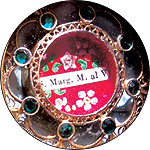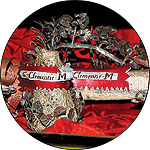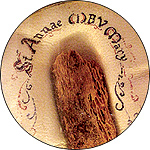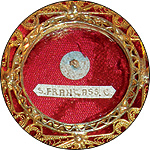With a past steeped in medieval counterfeits and grave robbing, relics have been saddled with a bad rap almost as long as saints have been canonized. But the tradition itself predates Christianity; recorded veneration of remains ranges from Oedipus to Buddha. Today, the Roman Catholic Church reminds the faithful that these miniscule fragments-from bone chips to locks of hair to scraps of shroud-should serve as objects of reverence, not worship. Here’s where to see a few of these artifacts locally.
 |
QUEEN OF ALL SAINTS BASILICA 6280 North Sauganash Avenue >> This ornate basilica’s marble-gilded baptistery houses more than 150 first- and second-class relics, each barely bigger than a pinhead, representing the 12 apostles, scores of well- and lesser-known saints, and holy sites such as those of the true cross, the rock of Gethsemane, and the Last Supper table. Above, a relic of Saint Margaret Mary, a 17th-century French nun who believers say had mystical revelations |
| SHRINE OF OUR LADY OF POMPEII 1224 West Lexington Street >> Although most of its 250 relics are presented to the public just once a year, on each saint’s feast day, Our Lady of Pompeii plans to display one newly acquired relic year-round: that of Mother Frances Cabrini, the first canonized U.S. citizen and founder of numerous orphanages and schools, who died in Chicago in 1917. On loan from Rome, the relic gives locals a place to remember Cabrini while her Chicago shrine undergoes renovation. |
| OUR LADY OF SORROWS BASILICA 3121 West Jackson Boulevard >> In addition to a relic-outfitted side chapel devoted to St. Peregrine, patron of cancer patients, the basilica houses a backroom-formerly a private chapel for friars of the Servite Order-stocked with saints’ re- mains. Although some names are unfamiliar, the near finger-sized fragments, draped in faded velvet and entombed in mini sarcophagi (above), are a sight for believers and non alike. |
 |
| HOLY NAME CATHEDRAL 735 North State Street >> “Normally, a church tries to get relics for the saint they’re named after, but since we’re Holy Name, and Jesus Christ rose from the dead, that would have been impossible,” says Bishop Timothy Lyne. Instead, the cathedral possesses first-class relics of St. John and St. Timothy, installed in the church’s altar during a 1968-69 remodeling. |
 |
NATIONAL SHRINE OF ST. ANNE AT OUR LADY OF FATIMA CHURCH 2751 West 38th Place >> At one inch, this scrap of a shinbone (shown above) may not look like much. But its supposed source, Anne-mother of Mary, grandmother of Jesus-has inspired many a favor (the church avoids calling them miracles) at this elaborate shrine, decorated with crutches of the once afflicted who, it is said, left the site healed. |
| ST. PETER’S CHURCH 110 West Madison Street >> This downtown parish is home to relics of two early 13th-century saints, Anthony of Padua and Francis of Assisi (above). “Francis was the founder of our order, the Franciscans, so it’s very important for us to have some reminder of him,” says Father Robert Hutmacher. |
 |
| NATIONAL SHRINE OF ST. JUDE AT OUR LADY OF GUADALUPE CHURCH 3200 East 91st Street >> Established in 1929 as the city’s first parish dedicated to Hispanic immigrants, this shrine and its relic of Jude, patron of difficult cases, struck a poignant note with the church’s Depression-era founding flock. The Dominican Shrine of St. Jude Thaddeus, 1909 South Ashland Avenue, houses another relic belonging to St. Jude. |
|
GLOSSARY First-class relic: A fragment of the physical remains, such as a bone shard or tooth splinter, of a saint or not-yet-canonized holy person. Second-class relic: An object, like a shroud or robe, considered sanctified by its proximity to the holy person’s body. Major or minor relic: A classification pretaining to size; the majority of relics are minor, or about the diameter of a pencil eraser. Reliquary: A relic case; reliquaries vary from jewelry boxes to filigreed frames to miniature glass caskets. |


